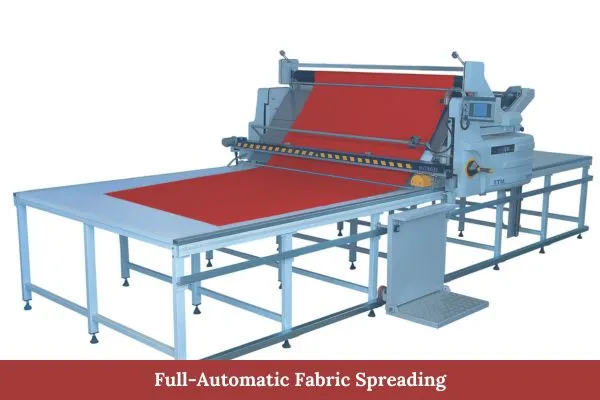One of the crucial processes in the garment industry involving laying out fabric is fabric spreading. Fabric spreading in the garment industry helps to ensure the accurate production of garments, minimize fabric waste, and maintain a consistent quality check in the production process.
Table of Contents

What is Fabric Spreading in Garment Industry?
‘Spreading’ in the garment industry is the act of arranging several layers of fabric on a spreading table or spreading machine to get clothes ready for cutting and sewing. Fabric spreading is the process of laying fabrics in stack form as per marker length and width.
In garments industry, Fabric or clothing spreading refers to the process of smoothly laying out the fabric in a specific length of plies or layers. Usually, fabrics use the manual laying-up method. To be specific, knitted and woven fabrics get to be laid in a single ply. In other cases, they are laid up in several plies for the continuous cutting process in a single operation.
Objectives:
Fabric lay is done to save fabric and time. Which reduces the overall production cost.

Requirements of Spreading
i. Tension:
The test on the ply should be minimal. Should not be done in lose condition otherwise shrinkage and other defect will occurs.
There are some fabrics where inherent tensions which may be developed during the fabric weaving, finishing, roll formation. These fabrics needs to be tension free.
Some fabric tends to loose and become longer (knitted, textured yarn, DTY, elastic yarn). These fabric fabric must be cut 12-24hrs before spreading/ laying.
ii. Alignment:
Alignment is done as per the length and width of a marker. It’s placed perfectly within the length and width of the marker. Each of the piles is placed and controlled along the width maintaining the selvedge of at least one side in that same line.
Types of Fabric Spreading
Fabric types and methods are not the same. Some common fabric spreading methods include one-way, zigzag, face-to-face, laser, and manual spreading.

However, only two types of spreading are used in the Garment Industry. For instance:
- Flat Spreading: Here, the same length of several fabrics gets to be arranged one on top of the other.
- Stepped Spreading: Here, some fabrics of similar length get to be arranged one on top of the other in various steps.
Fabric Lay:
Shape of the fabric atained as per spreading is called fabric lay. Two or more layer of fabric file is used.
Types of Fabric Lays in Spreading
Two types of fabric lay are used in spreading. For instance:
- Straight Lay: A single ply of fabric is spread as per the marker length.
- Stepped Lay: A step is formed when the plies get to be laid up in a completely different length.
Types of Fabrics go through Spreading Process
A wide range of fabrics usually experience the spreading process. A specific fabric type is chosen based on the design, function, and aesthetics.
Some of the fabric types are:
- Woven Fabrics: Such as cotton, denim, polyester, wool, and silk.
- Knit Fabrics: Interlocked version of loops of yarn.
- Synthetic Fabrics: Such as nylon, rayon, and spandex.
The fabric spreading process goes through two methods in the garment industry. They are:
- Manual Method
A hand-spreading method.

- Mechanical Method
Using machinery to lay out some fabric layers is basically the mechanical method. There are two types of mechanical methods. For instance:
- Semi-Automatic Method
It involves a combination of both machine and manual labor. Semi-automatic mechanical spreading often consists of having machines unroll and guide the fabric. Meanwhile, human operators take care of things like matching edges, removing wrinkles, and modifying layers of fabric as necessary.

- Full-Automatic
automatic fabric spreading machine is a highly automated process of spreading in the garment industry, performed by machinery. Here, machinery performs the majority of tasks.

Importance of Fabric Spreading in the Garment Industry
Fabric spreading is important in enhancing efficiency, cost-effectiveness, and consistency within the garment industry, as it is a paramount step in creating high-quality garments. Some of the importance of fabric spreading are given as follows:
- Cutting Accuracy: Fabric spreading ensures accurate fabric cutting or alignment so that garment pieces come up with precise, error-free, and improved-quality versions.
- Quality Control: Spreading helps detect defects in garments before they reach the sewing stage.
- Consistency Maintain: Spreading methods help maintain uniform garment production, resulting in consistent size and fit.
- Sustainability: In the garment industry, any efficient fabric spreading can contribute to sustainability- reduction of fabric waste, consumption of few resources, the negative impact of environment minimization, and ultimately shortened lead times for production.
Conclusion
The type of fabric, intended quality, equipment, and demands of the production process all influence, as determinants, the fabric spreading. Intending to cut fabric in proper tension to ensure the fabric shape and dimension in a proper setting and save time by cutting down some fabric layers at a time, fabric spreading in the garment industry is the foundation for successful production.
